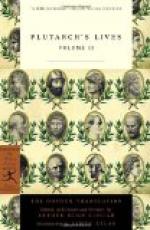[Footnote 80: The movements of the barbarians are not clearly stated. It appears from what follows that the Cimbri entered Italy on the north-east over the Noric Alps, for their march brought them to the banks of the Adige. Florus says that they came by the defiles of Tridentum (Trento). The Teutones, if they marched through the Ligurian country along the sea to meet Marius, who was near Marseilles, must have come along the Riviera of Genoa.]
[Footnote 81: Plutarch calls her a Syrian. Martha may have been a Syrian name, as well as a Jewish name. Syrians and Jews flocked to Rome in great numbers under the later Republic and the Empire, and got their living in various ways not always reputable. The Jews at Rome used to cause disturbances in the popular assemblies in Cicero’s time. (Cic. Pro Flacco, c. 28.) Jews and Syrians are often mentioned together by the Roman writers. The Jews at Rome were greatly troubled at the assassination of the Dictator Caesar, and they crowded round the place where the body was burnt for nights in succession. Caesar had rather favoured the nation for their services in the Alexandrine War. (Suetonius, Caesar, c. 84, and Casaubon’s note.)]
[Footnote 82: He wrote on Natural History; among other things, a History of Birds, from which this story is probably taken. There is evidently an error in the text [Greek: espazonto tous stratiotas]. I have adopted Reiske’s emendation.]
[Footnote 83: Pessinus was in Galatia, properly a part of Phrygia, and the seat of the temple of Cybele, the Mother of the Gods or the Great Mother. In the second Punic War the Romans sent ambassadors to Pessinus, and got permission to convey to Rome the Great Mother of the Gods, who was a sacred stone. The Sibylline Books had declared that when a foreign enemy was in Italy, he could be driven out, if the Idaean mother, for Cybele was so called also, was brought to Rome. The goddess was received at Rome (B.C. 203) with great respect, and placed in the temple of Victory. (Livius, 29, c. 10, &c.) Plutarch does not explain how the goddess now happened to be in Asia and Rome at the same time, for there is no account of her leaving Rome after she was taken there. The annual celebration called Megalesia, that is, the festival of the Great Mother, was instituted at Rome in honour of the goddess, and celebrated in the spring. (Herodianus, i. 32, &c.) It was a tradition that the stone fell from the skies at Pessinus. There was another great stone in Syria (Herodianus, v. 5), in the temple of the Sun, which was worshipped: the stone was round in the lower part, and gradually tapered upwards; the colour was black, and the people Aida that it fell from heaven. It is probable that these stones were aerolites, the falling of which is often recorded in ancient writers, and now established beyond all doubt by repeated observation in modern times. (See Penny Cyclopaedia, “AErolites.”) There is a large specimen in the British Museum.




